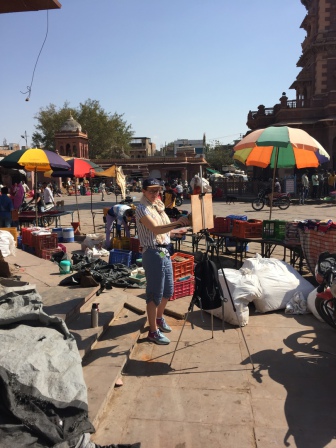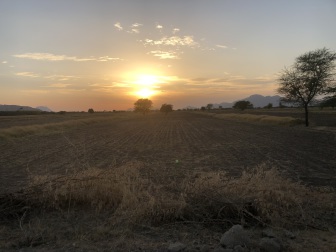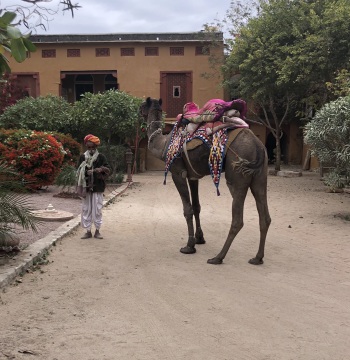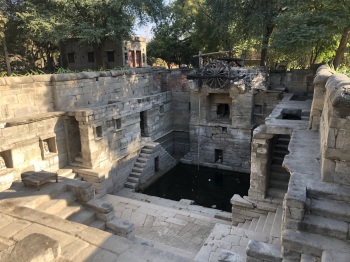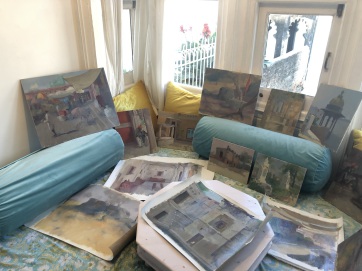Travels
Diary of India 2019
After a honeymoon spent in Rajasthan 8 years ago, we have often wanted to return. I especially longed to paint the many splendid sights and scenes on offer. Eventually this year we set off, without our children, for a trip between Jodhpur and Udaipur. I packed a few clothes and a huge amount of painting equipment, while Rob was keen to explore the agricultural and cultural life and read many books.
Jodhpur
After long flights and a lethargic 24 hours in Delhi we flew on to Jodhpur.
Parched farm land was clearly visible from the sky, making a striking change from our last visit 8 years ago where a lush green vista was on view from above. Rajasthan has suffered a poor Monsoon (usually between July and September each year) and is consequently brown and arid, many farmers have lost the second crop cycle of the year which would be due to harvest in early March after the Holi festival.
Flying in we knew nothing of these troubles; we landed and were swept into the charming mayhem of the city. Arriving late, having had a flight cancelation, and delay, the sun was already beginning to set.
In our short time we went straight to the Mehrangarh Fort which sits high above the city, hoping to catch the wonderful yellow sunset.
After some clambering over rocky spurs under the ramparts a perch presented itself, looking over the blue old city. The light at the end of the day in Jodhpur is spectacular with the desert dust staining the air a bright ocher. The blue city was set back with the famous pink Jodhpur sandstone in the fore; I caught a quick sketch into the sunset. Then to our lovely oasis of a hotel Ratan Villas for the night.
In the morning it was straight for the Sardar market. This market is world renowned and for good reason. I can’t imagine a place where more could be thrown at the senses. Smells can’t be painted but if they could I would have needed to conjure; incense, fresh vegetables, hot people, spices, fresh linen, cows and cow dung, cooking food, car fumes, sewage, flower petals and of course oil paint. I did two studies in the market under the protective gaze of the friendly folk whose stalls I had invaded, all the while feeling so lucky to know that places like this can be seen and freely enjoyed today. A health and safety officers nightmare.
When not painting Rob and I explored the tiny side streets where the textiles are produced. I say streets, but with more than 10 people in each 2m sq brightly painted cube, and only 30cm or so between shop fronts, it’s not really the same as Berwick high street. I especially enjoyed having to jump over small walls that had been erected between each work space. Then to lunch each day over the insanely
beautiful step well.
To contrast to the chaos of the market and the majesty of the fort I sought out the famous white cenotaphs, Jaswant Thadar, on the pink sand stone near Mehrangarh. These odes to the dead are as tranquil a spot as can exist on earth. The meditative atmosphere flowed around and I was allowed to sketch in front of 2 of the smaller cenotaphs.
PS. Interesting to note how differently painters are regarded to professional photographers. At special monuments the professional photographer is viewed as akin to vandal or miscreant, while the painter is regarded kindly. In retrospect my choice of easel (a photographer’s tripod with painters attachment) made life more complicated, and a lot of gesturing and showing of paint was needed to convince guards I was kosher.
Chanoud Ghar
After 3 action packed days in Jodhpur, Madan, our very sleepy driver, made a steady course for Chanoud, a remote village on the Thar desert edge. It was in arriving here that we were plunged into rural life proper and learnt more of the ways of local agriculture and its present struggle with the drought.
The Ghar or palace, is now run by the family as a hotel, and what a haven they have created. I would return here again and again. They seem to be balancing so elegantly on the edge between authenticity and comfort. The village outside the walls of the Ghar is a delight, and what comes forth from the village is most paintable indeed! The camel herder and, of course, his camel. The bight ladies tending to the little temple, and much more, along with the sumptuous surrounds of the hotel; enough inspiration for many days painting was on offer.
We went out at sunset with the owner of the hotel to the large local lake looking towards the Aravalli Hills to be fed a tea of Raj proportions as the day vanished. On route we drove (in an open top landrover made before my parents were born) past endless barren fields, dry wadis and an immense herd of goats and sheep roaming across the dusted land, tenderly steered by the red turbaned nomads, so famed in this area. The farm land is open out of cropping, so that the herders can graze their stock and the farmer benefits from the droppings. Sadly such symbiosis is rarer all the time in modern India so nomads often make off to the Ganges basin some 2000k away if needs be. On route we saw Sarus cranes, some of the largest birds on earth, standing at 150cm with wonderful colouring and a beautiful cry, among other wildlife. And then to the shrunken salt lake, still serene, for our tea.
The village comes from another age. Three religions; Muslims, Jains and Hindus. 36 castes among the 3 faiths. Each entirely an island, though on friendly terms with each other. All communities seek paternalistic oversight from the Ghar family, who before independence, were their royalty, and masters. The people have now elected them as they democratic representatives, and most common disputes, town plans and community guidance seem to resolve from the male heads of the family to the menfolk of each group who often solicit advice. The conspicuous exclusion of women reminds one that girls are often married very young in rural Rajasthan and will often receive sadly limited education and few life prospects outside of the domestic.
The head family are dogged defenders of the local farmers land claims against an opportunistic local government attempting to annex land, leaving the village farmers to rely on the family to fight their corner in court for decades on end in some cases.
Most people seemed largely fulfilled in their rural idyll, and the energy and friendliness of the village was heart-warming. I cannot say that all of the traditional system sat easily with me by any stretch, especially in the case of women’s subservient lot and the societally enforced apartheid of castes. That said the charm of most of the inherited rural practice was abundant and it’s such a genuine experience to see the society through an unvarnished lens.
Rawla Narlai
Three fully immersive days passed at Chanoud, then off we set for Rawla Narlai, further along the Aravalli hills. This larger village is under the huge granite mass of Elephant rock, and a steep walk up the hill is essential to see the spectacular views over the country around. The hill is home to a mass of wildlife from Langur monkeys, who come down to the hotel garden to raid the green plants in the evening, to chipmunks by the dozen and many wild boar.
On our first day it was Maha Shivaratri (the Hindu god Shiva’s) festival day, and loud celebrations rang around the village. The shrines and temple on the top of the hill were bustling with people paying their respects, which added some colour notes to my small shrine sketch. Early the next morning it was deserted of worshipers so only the monkeys presented themselves for painting. We also walked out to a stepwell belonging to the hotel’s owners. This little paradise was one of the most beautiful spots we saw in our whole trip. Before we knew it our two days were quickly expired and on to Udaipur we went.
Udaipur
This an extraordinary place, a city in and around a massive manmade lake. The Lake was low after the light monsoon, yet the sight of knotted palaces running down to the water’s edge is something to behold none the less. We also had the fun and fear of a Tuktuk ride, and crash, on route to our hotel, located in the tiny streets of the city centre, where cars cannot venture. In fact, the nearest moments I’ve come to being run over can all be counted in the two days we were in Udaipur, but glorious fun and bustle to be so central. Our hotel room even looked out over its’ own chhatri (little lake side folly), so I painted out towards lake palace from the balcony.
Then it was off in search of one of the views that I’ve planned the whole trip around. I remember the Ghats (steps down to the lake edge) from our first trip 8 years ago, and in particular one called Hanuman Ghat, which I thought so perfect back then. It’s tucked away and slightly fiercely guarded though in theory open to the public. We set off immediately to paint there only to find it shut. It remained shut for the next 4 hours, in spite of my begging through the peep hole in the ornate ancient door to come in Finally, at 4.30 in the afternoon as the sun began to set in spectacular Indian fashion the door miraculously opened, we deposited our shoes and rushed in. I had saved my largest panel for this view and it didn’t disappoint. I flailed at the board to get the evening light as Rob finished his book and felt quite delirious when we packed up. The next day, with one last opportunity on offer, we set off in a boat to the island Jag Mandir, famous for appearing in Octapussy, to paint some of the lovely carved elephants, then a long lunch and the trip of many flights home claimed us.
In all I started 16 paintings, and plan to use some as studies to blow up to the larger scale in the studio.
It’s simply a fact that India gets under the skin. It’s so lively, ancient, colourful, full of kind and beautiful people, full of chaos and smells and musk. It’s the ultimate middle finger to the health and safety mindset of the west, and one can’t deny that this attitude does provide its share of tragic effects, doubtless, but is rather nearer to nature. No wonder people return over again to this spectacle of the country.
s i
